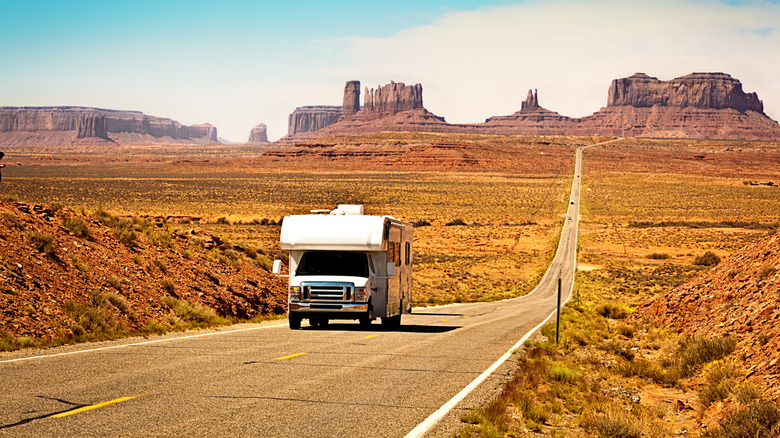Don't Forget The RV 3-3-3 Rule On Your Next Road Trip
Embarking on a road trip in an RV is a thrilling adventure, promising freedom, exploration, and unforgettable experiences. But as any seasoned traveler knows, successful journeys require a delicate balance of planning and spontaneity. Enter the RV 3-3-3 rule — a game-changer for road warriors seeking to maximize enjoyment while minimizing stress.
The RV 3-3-3 rule is a handy guideline for RV travelers to maximize comfort and safety during road trips. It entails three principles: drive no more than three hours per day, arrive at your destination by 3 p.m., and stay at each location for at least three days.
Why these three tenets? It's simple: it's all about balance. By setting reasonable limits on driving time, arrival deadlines, and length of stay, you're creating a framework that promotes safety, relaxation, and exploration. Physiologically, our bodies thrive on routine and rhythm. By adhering to a predictable schedule, you're allowing your internal clock to sync with the natural rhythms of your road journey, reducing stress and promoting overall well-being. Moreover, the 3-3-3 rule encourages mindfulness and intentionality in your travels. Instead of rushing from one destination to the next, you're encouraged to slow down, savor the moment, and fully immerse yourself in the journey.
Limit yourself to three hours on a road a day
Picture this: cruising down scenic highways, the open road stretching out before you, and the promise of new adventures just around the bend. But beware! Extended periods behind the wheel can swiftly transform your idyllic journey into a grueling ordeal of exhaustion and irritation. Spending prolonged hours driving not only induces fatigue but also heightens the risk of accidents. While in the US and Canada, long-haul drivers are permitted to operate their vehicles for up to 14 and 13 hours a day respectively, provided they adhere to minimum break requirements, the EU mandates breaks every 4.5 hours. For folks who are always on the road, these hours may seem manageable, but research published in Applied Ergonomics reveals that driver discomfort escalates even over the course of a 130-minute drive. And so the three-hour driving limit is one that prioritizes safety and health.
But the three-hour limit is also about your overall enjoyment of the journey. By breaking up your drive into manageable chunks, you'll have more time to appreciate the scenery. This approach grants you the freedom to veer off the beaten path and explore the eclectic array of roadside attractions that pepper the route, which you otherwise may have zoomed past. From quaint mom-and-pop diners serving up mouth-watering delicacies to quirky landmarks steeped in local lore, each detour adds depth and richness to your journey, transforming it from a mere means of transportation into a captivating adventure.
Timing is everything: arrive by 3 p.m.
Have you ever found yourself pulling into a campground under the cloak of darkness, grappling to start a campfire amidst the dim glow of your headlights? Or perhaps you've reached your destination well past sunset, the stars obscured by the veil of night, robbing you of the chance to behold its natural splendor? Say goodbye to those frustrations with the 3 p.m. arrival rule. Whether you're hiking through national parks or lounging on sandy beaches, arriving early ensures you make the most of every moment.
Arriving at your destination by mid-afternoon gives you the gifts of time and light. With ample daylight to spare, you can leisurely scout out the perfect camping spot, ensuring both comfort and tranquility for the night ahead. But the benefits of the 3 p.m. rule extend far beyond mere practicality. It's about reclaiming the essence of travel — the joy of exploration, the thrill of discovery. With daylight hours still at your disposal, you're free to delve into a myriad of adventures, each more exhilarating than the last. And let's not forget the culinary delights that await. With time on your side, you can indulge in leisurely dining experiences, whether you're barbecuing over a campfire or sampling the local fare from a local market.
Soak it in for at least three days at each destination
In today's fast-paced world, it's easy to fall into the trap of rushing from one place to the next, ticking off items on your travel checklist like a tourist on a mission. But there's a different approach — one that promises richer, more fulfilling adventures. Rather than racing from one place to another, the 3-3-3 rule suggests spending at least three days at each stop along your journey. This deliberate choice allows for a richer exploration of the area, providing ample time to savor the essence of the destination without the pressure of time constraints.
Sometimes, on particularly long journeys when the days blend together, it's easy to lose track and wonder, "Wait, how many days have we been here?" Instead of getting bogged down in the days, I've found a spin on the traditional 3-3-3 rule that works for me: I aim for a three-night stay at every stop on my road trips. With three nights, you can still dive deep into the vibe of your destination without feeling rushed or tied down. But this rule also gives you some wiggle room in case you need to depart earlier than expected, or you've arrived later than anticipated because your RV floors demanded a cleaning. So, even if you get closer to two days at a destination, those three nights will provide you with the rest and rejuvenation you need without compromising your enjoyment in a location.



